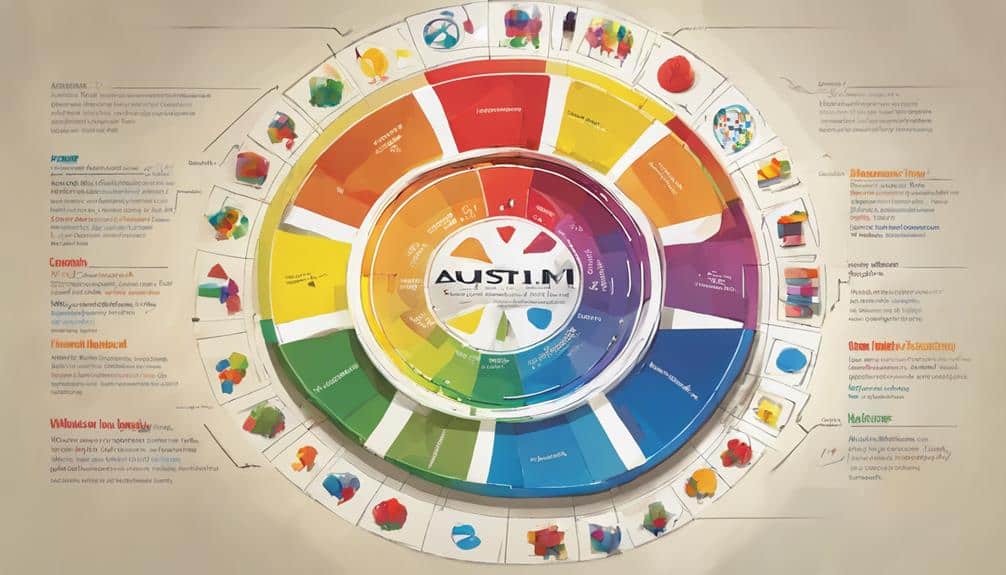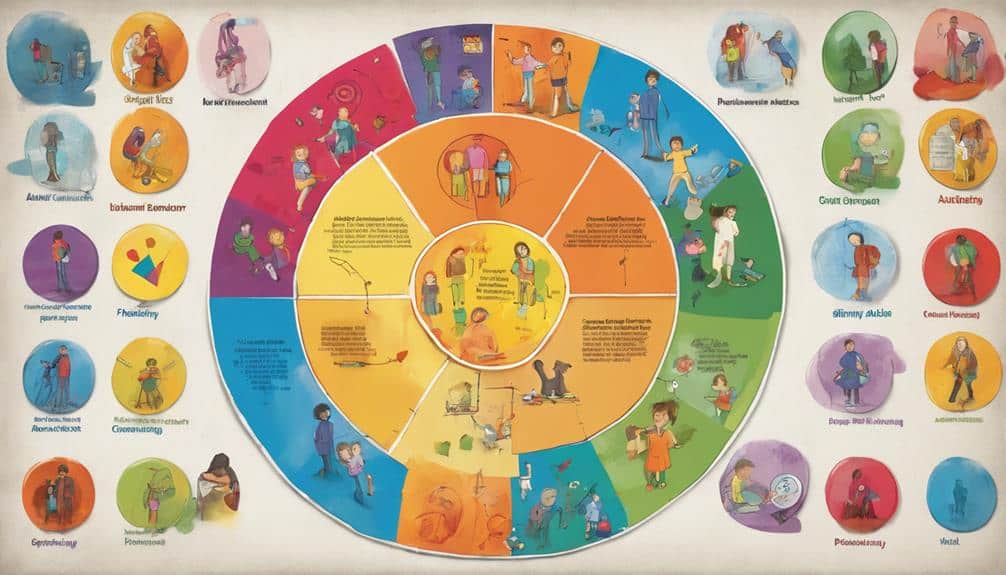Autism Spectrum Wheel
Exploring the intricacies of the Autism Spectrum Wheel reveals a nuanced understanding of the diverse characteristics within the autism community.
As I investigate the different sections of the wheel, each segment uncovers a unique aspect of the spectrum, shedding light on the multifaceted nature of Autism Spectrum Disorder.
Through this visual representation, we can discover a wealth of insights that challenge preconceptions and foster a deeper appreciation for the rich tapestry of experiences within the autism spectrum.
Key Takeaways
- Provides comprehensive understanding of autism spectrum characteristics.
- Guides tailored support strategies for individuals with autism.
- Enhances awareness and acceptance of diverse autism profiles.
- Essential compass for creating inclusive environments and promoting neurodiversity.
Understanding the Autism Wheel

The Autism Wheel serves as a thorough tool for categorizing and understanding the varied characteristics of individuals across the autism spectrum. This categorization is important in comprehending the diverse range of traits that Autistic people may exhibit.
The Autism Wheel features key aspects such as social interaction, sensory processing, and cognitive abilities. Understanding these components is critical for providing tailored support to individuals on the spectrum. By recognizing the nuances in each of these areas, caregivers, educators, and professionals can create inclusive environments that cater to the specific needs of Autistic individuals.
Acknowledging the spectrum nature of autism through the Autism Wheel promotes acceptance and appreciation of neurodiversity. Embracing this tool aids in fostering respect and understanding for the strengths and challenges that come with being on the autism spectrum.
Essentially, the Autism Wheel acts as a compass, guiding efforts towards meaningful support and inclusivity for individuals with autism.
Exploring Wheel Characteristics

Exploring the characteristics of the Autism Spectrum Wheel sheds light on the intricate profiles of individuals across the autism spectrum. This tool helps in understanding the diverse aspects of autism, such as communication, social interaction, repetitive behaviors, sensory processing, and cognitive abilities. By delving into these key areas, the Wheel provides insights into the holistic view of autism, emphasizing the interconnectedness of different traits and the individual variation that exists within the spectrum.
The Autism Spectrum Wheel serves as a valuable resource for professionals, educators, and caregivers, offering guidance on tailored support strategies that consider the multifaceted nature of autism. It encourages a thorough approach to addressing the needs of individuals on the spectrum, highlighting the importance of recognizing and appreciating the diverse strengths and challenges present in each person. By utilizing the Wheel to explore these characteristics, a more detailed understanding of autism can be achieved, fostering greater awareness, acceptance, and support for individuals with autism.
Navigating Wheel Sections

Exploring through the sections of the autism spectrum wheel offers a thorough understanding of the diverse aspects that shape an individual's characteristics and experiences within the spectrum. Sailing through these sections is pivotal for comprehending the intricate details of autism and tailoring support effectively.
- Communication: Understanding how communication challenges manifest in individuals on the spectrum is essential for providing appropriate support.
- Repetitive Behaviors: Exploring this section sheds light on the role repetitive behaviors play in coping mechanisms and sensory regulation.
- Sensory Processing: Delving into sensory processing highlights how hypersensitivities or hyposensitivities can impact daily functioning and social interactions.
Supporting Individuals on Wheel

Exploring the Autism Spectrum Wheel enables a thorough understanding of the diverse characteristics and experiences that shape individuals within the spectrum, importantly informing tailored support strategies for individuals on the spectrum.
Understanding individual support needs is essential for providing effective assistance to Autistic individuals. By focusing on communication, social interaction, repetitive behaviors, sensory processing, and cognitive abilities, caregivers and professionals can offer targeted help.
Creating inclusive environments that cater to these specific requirements is vital in fostering a supportive atmosphere. Embracing neurodiversity and recognizing the unique talents and challenges within the spectrum is key to providing meaningful assistance.
By utilizing the Autism Spectrum Wheel, individuals can work towards promoting awareness, understanding, and acceptance of autism. This, in turn, leads to the development of more empowering environments that cater to the diverse needs of those on the spectrum.
Ultimately, the goal is to celebrate differences and create spaces where every individual feels valued and supported.
Benefits of Autism Spectrum Wheel

The Autism Spectrum Wheel offers a thorough framework for understanding and addressing the multifaceted aspects of autism, aiding in tailored support strategies for individuals within the spectrum. This tool provides significant benefits for people on the autism spectrum:
- Enhanced Understanding of Autism: By encompassing communication, social interaction, sensory processing, and cognitive abilities, the Wheel deepens comprehension of the complexities of autism.
- Tailored Support: Professionals, educators, and caregivers can utilize the Wheel to develop personalized interventions that cater to the diverse strengths and challenges of each individual.
- Promotion of Neurodiversity: The Wheel promotes acceptance and appreciation of neurodiversity by highlighting the unique characteristics and interconnectedness of various traits in individuals with autism.
Frequently Asked Questions
What Is the Wheel Theory of Autism?
The Wheel Theory of Autism is a model that aids in understanding neurodiversity and challenges in social communication, sensory processing, repetitive behaviors, and executive functioning. It highlights the need for acceptance and tailored support for individuals on the spectrum.
What Is the Autism Wheel Instead of the Spectrum?
When considering autism, the wheel concept offers a unique perspective, emphasizing a neurodiversity approach. It explores social communication, sensory processing, executive functioning, emotional regulation, cognitive development, and behavioral patterns. This theory complements the spectrum by focusing on individual experiences, informing tailored support strategies.
What Are the Symptoms of the Autism Spectrum Wheel?
Symptoms of the Autism Spectrum may include social difficulties, communication challenges, repetitive behaviors, sensory sensitivities, executive functioning issues, and emotional regulation struggles. Diagnosis, early intervention, therapy, education plans, and advocacy are crucial for support.
What Are the 5 Autism Spectrum Disorders?
I'll address the five autism spectrum disorders. They are autistic disorder, Asperger's syndrome, pervasive developmental disorder not otherwise specified (PDD-NOS), childhood disintegrative disorder, and Rett syndrome. Each presents distinct characteristics and diagnostic criteria.
Conclusion
To wrap up, the Autism Spectrum Wheel serves as a compass guiding us through the diverse landscapes of autism. Just as each spoke on the wheel leads to different aspects of the spectrum, understanding and acceptance are key in supporting individuals with autism.
Like a kaleidoscope of colors, the wheel reflects the unique experiences and perspectives of those on the spectrum, reminding us to approach each individual with empathy, patience, and a person-centered mindset.







